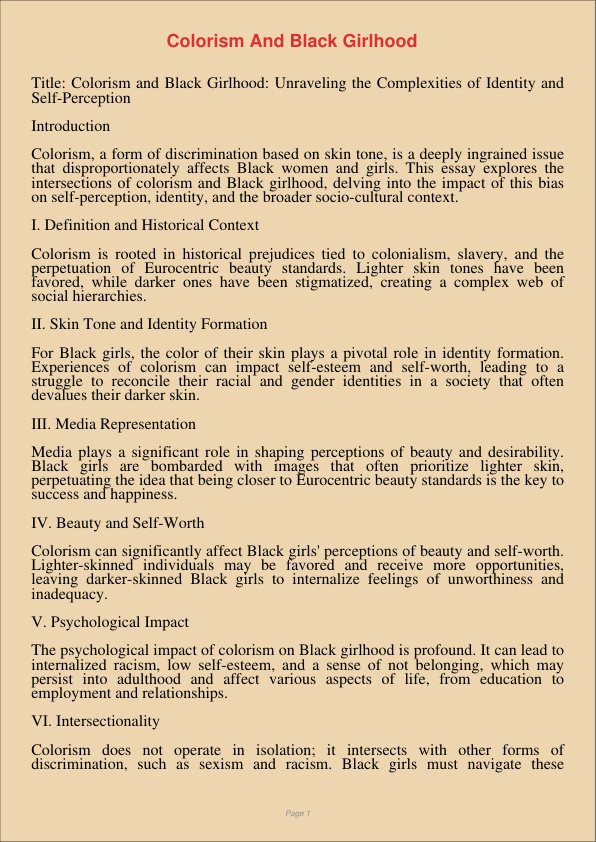Colorism And Black Girlhood
Jan 12, 2024
black girlhood
colorism
Gender & Sexual Studies
Macro & Microeconomics

Title: Colorism and Black Girlhood: Unraveling the Complexities of Identity and Self-Perception
Introduction
Colorism, a form of discrimination based on skin tone, is a deeply ingrained issue that disproportionately affects Black women and girls. This essay explores the intersections of colorism and Black girlhood, delving into the impact of this bias on self-perception, identity, and the broader socio-cultural context.
I. Definition and Historical Context
Colorism is rooted in historical prejudices tied to colonialism, slavery, and the perpetuation of Eurocentric beauty standards. Lighter skin tones have been favored, while darker ones have been stigmatized, creating a complex web of social hierarchies.
II. Skin Tone and Identity Formation
For Black girls, the color of their skin plays a pivotal role in identity formation. Experiences of colorism can impact self-esteem and self-worth, leading to a struggle to reconcile their racial and gender identities in a society that often devalues their darker skin.
III. Media Representation
Media plays a significant role in shaping perceptions of beauty and desirability. Black girls are bombarded with images that often prioritize lighter skin, perpetuating the idea that being closer to Eurocentric beauty standards is the key to success and happiness.
IV. Beauty and Self-Worth
Colorism can significantly affect Black girls’ perceptions of beauty and self-worth. Lighter-skinned individuals may be favored and receive more opportunities, leaving darker-skinned Black girls to internalize feelings of unworthiness and inadequacy.
V. Psychological Impact
The psychological impact of colorism on Black girlhood is profound. It can lead to internalized racism, low self-esteem, and a sense of not belonging, which may persist into adulthood and affect various aspects of life, from education to employment and relationships.
VI. Intersectionality
Colorism does not operate in isolation; it intersects with other forms of discrimination, such as sexism and racism. Black girls must navigate these complex intersections, often facing double or triple biases based on gender, race, and skin tone.
VII. Empowerment and Resistance
Despite the challenges, many Black girls and women are actively engaged in movements to resist colorism. Embracing natural hair, celebrating dark skin, and challenging Eurocentric beauty standards are part of this resistance, contributing to a broader narrative of self-empowerment and self-acceptance.
VIII. Education and Representation
Addressing colorism and its impact on Black girlhood requires a concerted effort to educate society about the harm it perpetuates. Representation in media, education, and leadership roles is crucial in fostering a more inclusive and equitable society.
IX. Supporting and Empowering Black Girls
Supporting and empowering Black girls means providing safe spaces for dialogue, access to mentors and role models, and creating opportunities that celebrate the richness and diversity of their identities.
Conclusion
Colorism and its influence on Black girlhood are part of a larger narrative of discrimination, inequality, and social injustice. To combat the effects of colorism, society must actively work to deconstruct harmful beauty standards, challenge media representations, and support and empower Black girls in their journey toward self-acceptance and self-worth. Recognizing and addressing the complex interplay of identity, race, and gender is essential in fostering a more inclusive and equitable world for Black girls and women.